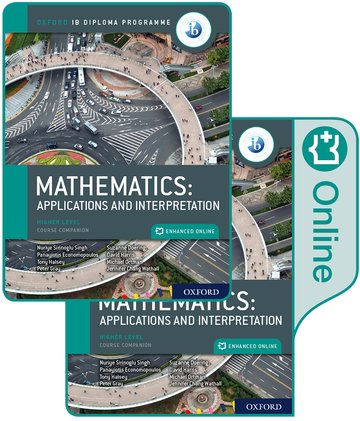Oxford IB Diploma Programme: IB Mathematics: applications and interpretation, Higher Level, Print and Enhanced Online Course Book Pack
Author Panayiotis Economopoulos, Author Tony Halsey, Author Suzanne Doering, Author Michael Ortman, Author Nuriye Sirinoglu Singh, Author Peter Gray, Author David Harris, and Author Jennifer Chang Wathall
Price: £72.99
+VAT
ISBN:
978-0-19-842704-9
Publication date:
21/03/2019
Pack:
832 pages
Dimensions:
255x195mm
Availability: In stock.

Digital Evaluation
Schools can access an online copy of the whole book free of charge for 30 days. At the end of the evaluation period, you can buy printed copies here or through your usual sales consultant or bookseller.
Free Trial
Register your school for a free trial of the digital subscription. For more information contact your local educational consultant.
You can use the basket to:
- pay by credit card
- order on account
- forward to a colleague
Description
Features
- Address all aspects of the new DP Mathematics: applications and interpretation HL syllabus via an Enhanced Online Course Book Pack - made up of one full-colour, print textbook and one online textbook, including extensive teacher notes
- Ensure learners are ready to tackle each topic with targeted 'Prior Knowledge' worksheets, linked to 'Before You Start' summaries and exercises at the start of every chapter
- Deliver in-depth coverage of all topics through clear explanations and worked solutions, animated worked examples, differentiated exercises and worksheets, with answers provided
- Adopt a concept-based approach with conceptual lenses and microconcepts woven into every chapter, plus rich investigations that integrate factual and conceptual questions - leading to meaningful, content-specific conceptual understanding
- Deepen mathematical understanding via inquiry-based tasks that relate to the content of each chapter, 'international mindedness' features, regular links to Theory of Knowledge, and activities that target ATL skills
- Support students' development of a mathematical toolkit, as required by the new syllabus, with modelling and investigation activities presented in each chapter, including prompts for reflection, and suggestions for further study
- Thoroughly prepare students for IB assessment via in-depth coverage of course content, overviews of all requirements, exam-style practice questions and papers, and a full chapter supporting the new mathematical exploration (IA)
- Includes support for the most popular Graphic Display Calculator models
- This Online Course Book will be available on Oxford Education Bookshelf until 2029. Access is facilitated via a unique code, which is sent in the mail. The code must be linked to an email address, creating a user account.
- Access may be transferred once to a new user, once the initial user no longer requires access. You will need to contact your local Educational Consultant to arrange this.
This page was last updated on 23 December 2024 at 09:00 GMT
Table of Contents
Measuring space: accuracy and geometry
1.1: Representing numbers exactly and approximately
1.2: Angles and triangles
1.3: three-dimensional geometry
Representing and describing data: descriptive statistics
2.1: Collecting and organizing data
2.2: Statistical measures
2.3: Ways in which we can present data
2.4: Bivariate data
Dividing up space: coordinate geometry, lines, Voronoi diagrams, vectors
3.1: Coordinate geometry in 2 and 3 dimensions
3.2: The equation of a straight line in 2 dimensions
3.3: Voronoi diagrams
3.4: Displacement vectors
3.5: The scalar and vector product
3.6: Vector equations of lines
Modelling constant rates of change: linear functions and regressions
4.1: Functions
4.2: Linear models
4.3: Inverse functions
4.4: Arithmetic sequences and series
4.5: Linear regression
Quantifying uncertainty: probability
5.1: Theoretical and experimental probability
5.2: Representing combined probabilities with diagrams
5.3: Representing combined probabilities with diagrams and formulae
5.4: Complete, concise and consistent representations
Modelling relationships with functions: power and polynomial functions
6.1: Quadratic models
6.2: Quadratic modelling
6.3: Cubic functions and models
6.4: Power functions, inverse variation and models
Modelling rates of change: exponential and logarithmic functions
7.1: Geometric sequences and series
7.2: Financial applications of geometric sequences and series
7.3: Exponential functions and models
7.4: Laws of exponents - laws of logarithms
7.5: Logistic models
Modelling periodic phenomena: trigonometric functions and complex numbers
8.1: Measuring angles
8.2: Sinusoidal models: f(x) = asin(b(x-c))+d
8.3: Completing our number system
8.4: A geometrical interpretation of complex numbers
8.5: Using complex numbers to understand periodic models
Modelling with matrices: storing and analyzing data
9.1: Introduction to matrices and matrix operations
9.2: Matrix multiplication and properties
9.3: Solving systems of equations using matrices
9.4: Transformations of the plane
9.5: Representing systems
9.6: Representing steady state systems
9.7: Eigenvalues and eigenvectors
Analyzing rates of change: differential calculus
10.1: Limits and derivatives
10.2: Differentiation: further rules and techniques
10.3: Applications and higher derivatives
Approximating irregular spaces: integration and differential equations
11.1: Finding approximate areas for irregular regions
11.2: Indefinite integrals and techniques of integration
11.3: Applications of integration
11.4: Differential equations
11.5: Slope fields and differential equations
Modelling motion and change in 2D and 3D: vectors and differential equations
12.1: Vector quantities
12.2: Motion with variable velocity
12.3: Exact solutions of coupled differential equations
12.4: Approximate solutions to coupled linear equations
Representing multiple outcomes: random variables and probability distributions
13.1: Modelling random behaviour
13.2: Modelling the number of successes in a fixed number of trials
13.3: Modelling the number of successes in a fixed interval
13.4: Modelling measurements that are distributed randomly
13.5: Mean and variance of transformed or combined random variables
13.6: Distributions of combined random variables
Testing for validity: Spearman's hypothesis testing and x2 test for independence
14.1: Spearman's rank correlation coefficient
14.2: Hypothesis testing for the binomial probability, the Poisson mean and the product moment correlation coefficient
14.3: Testing for the mean of a normal distribution
14.4: Chi-squared test for independence
14.5: Chi-squared goodness-of-fit test
14.6: Choice, validity and interpretation of tests
Optimizing complex networks: graph theory
15.1: Constructing graphs
15.2: Graph theory for unweighted graphs
15.3: Graph theory for weighted graphs: the minimum spanning tree
15.4: Graph theory for weighted graphs - the Chinese postman problem
15.5: Graph theory for weighted graphs - the travelling salesman problem
Exploration
© 2024 Oxford University Press. All rights reserved.






